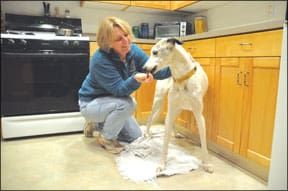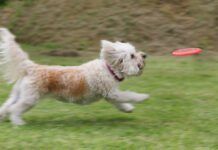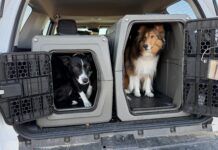Have you ever stopped to think about how many times a day you do something to your dog that involves physical contact? I’m not talking about petting him when he nudges up against your leg; I’m talking about grasping his collar, putting his leash on, picking him up, wiping debris from the corners of his eyes, wiping the mud off his paws, trimming fur somewhere on his body, and many more “husbandry” procedures that require various degrees of restraint and touch. Chances are you really only think about it when your dog protests, but chances are he thinks about it every time you reach for him.

288
If you’re lucky, he’s thinking good thoughts. This happens when he has a generally positive association with the outcome of your touch. These are the procedures he loves. Good associations can happen incidentally (Leash = going for a walk – Yay!) and you can create them deliberately (Touch collar, feed a treat; collar = treats – Yay!). If you’re not so fortunate or proactive, your dog may have negative associations with some of your procedures. These are the ones he avoids or actively resists.
Your dog will tell you
An owner who is skilled at observing and reading her dog’s body language is usually well aware when a canine pal is even slightly uncomfortable. (See “Say What?” WDJ November 2005). That’s “note to self” time; an opportunity to help change a mildly unhappy association to a very happy one, to avoid trouble down the road. Many owners, however, don’t notice until the dog is putting up major resistance. At that point it’s a much larger project to change the now well-established negative association. Once again, prevention is better than cure.
If you’re working with a pup or a young dog who doesn’t have many associations yet, don’t let him become even slightly uncomfortable. Treat every new procedure as an opportunity to make wonderful associations with all the handling procedures you may perform with him over the years.
Procedures
Here are examples of some of the procedures you can help your dog learn to love:
Reaching for the collar: Bet you can’t even count how many times this has happened to your dog, whether it’s reaching to put on a leash, to restrain him as a jogger goes by, to put him in his crate, or to hold him while you do something else to him. Most of the time grabbing for his collar is more reinforcing for you than for your dog, and he learns to shy away when you reach. This can be a serious safety concern, especially for those times when you have to grab him to protect him or prevent him from doing something inappropriate that could get him injured.
We do an exercise in our basic “good manners” classes called “Gotcha!” in which we teach the dogs that someone reaching for the collar consistently means something wonderful is coming. “Wonderful” is most often a tasty treat, but can also be a toy, a ball . . . or a leash and a walk.
The “Gotcha!” exercise is intended to desensitize your dog to having his collar grabbed, and to teach you the correct way to grasp a dog’s collar. This will help him enjoy having you reach for him, and greatly reduce the risk of a bite when you must take hold of your dog in a tense situation, since he will have learned to associate a collar grab with a reward.
Begin with your dog sitting in front of you. Say “Gotcha!” and feed him a treat. Repeat this until he brightens up when he hears the word. Then circle your hand over his head, say “Gotcha!” and feed him a treat. Repeat until he is calm when you do this, and happily anticipating a treat. Then touch his collar under his chin with the “Gotcha!” and treat.
Over several training sessions, gradually increase the intensity of your touches until you are grabbing the collar with the “Gotcha.” If at any time your dog flinches or tries to pull away you have moved forward too quickly. Back up a few steps in the process and start again.
Apply medication: When we found Dubhy, our Scottie, as a stray (some 10-plus years ago), he had badly infected ears and wanted no part of treatment. The dilemma when the ears are already infected is that no matter how much you add treats to the program, there’s still a negative association with the pain the treatment inevitably causes. Fortunately Dubhy is a forgiving soul, and in just two days the treat-association far outweighed the pain for him; the sight of his medication bottle would send him running to his mat in the kitchen to await treats – and treatment.
Most owners wait until ear cleaning or infection time to worry about how the dog will handle it. Wise owners spend a moment or two each day initially touching ears, then feeding a treat. Over time they increase the stimulus to rubbing the inside of the ears, feeding a treat; pressing a finger into the ear canal, feeding a treat; touching the inside of the ear with a moist cloth, feeding a treat; and even doing the same with a medication bottle and some benign liquid or gel, until the dog thinks nothing of having his ears invaded.
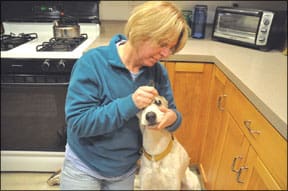
288
The same holds true for similar procedures: administering eye drops, brushing teeth, removing debris from the corners of your dog’s eyes, applying topical flea and tick preventatives . . . Start small, well before the procedure is actually critically important. Associate your movements and the various tools and accessories with really good treats, and when the day comes that you really do need to treat or clean your dog’s ears, he’ll be happily waiting on his mat for treatment, just like Dubhy.
Lifting: Lots of small dogs get picked up – a lot. Many of them don’t much like it, but are pretty helpless to prevent it, unless they snap and snarl. Just imagine how off-putting it would be to have a creature as much as 10 to 20 times your size (or more) swoop down and snatch you off the ground without warning, whenever it pleased.
When Scooter, our 10-pound Pomeranian, first joined our family two years ago, he was very resistant to being lifted. Even approaching him with lift-intention body language was enough to elicit a snarl. With a gradual association between good stuff and touch, then pressure, then lifting, he began to relax about being picked up. At that point we introduced a “Ready?” cue – in essence giving him notice of the pending lift, and the choice to be picked up.
Now, when I say “Ready?” I can feel him gather himself to be lifted, and when I say “Okay!” and pick him up he gives himself a small boost off the ground, as if to help. If I don’t feel him gather himself but I lift anyway, he will snarl. He still doesn’t appreciate being lifted if he is lying down, and I respect that. If he’s lying down and I need to pick him up I’ll invite him to stand, and if he declines I toss a treat to get him up. Treat consumed, he’s usually more than happy to play the “Ready?” game.
Wiping paws: Many dogs have negative associations with paw handling, in part because paws are most commonly touched and held for nail trimming – a procedure that creates a very negative association for lots of dogs. (See “Do My Nails, Please!” March 2009).
As with the “Gotcha” procedure, begin by just moving your hand near your dog’s paw and feeding a treat. When his eyes brighten and he looks for a treat as your hand moves toward him, add a brief, gentle touch before you treat. Gradually increase the length of time you touch, and then the amount of pressure. As things proceed well, eventually add small movements, working up to vigorous ones that approximate the movements you would use when toweling off his paws.
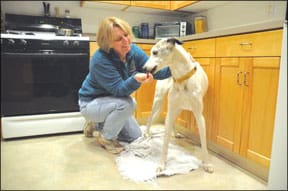
288
Over the same time period but in different sessions, introduce him to the towel. Show him the towel, feed him a treat. Repeat until you can tell by his response that he’s convinced towels make treats happen. Let him sniff the towel, and feed him a treat. Touch him with the towel on other parts of this body (assuming he’s comfortable with that) and feed him treats.
When he’s happy with both parts – the paw touching and the presence of the towel, you can put them together. Start with a brief gentle touch of the towel to his paws, and feed a treat. Gradually work up to a full, vigorous paw-toweling, making sure to keep the positive association as you progress.
Putting on a jacket: This is a complex procedure that may necessitate a considerable amount of canine cooperation. As with “wiping paws,” this one has two parts: the part where you create a positive association with touching the dog’s body parts, and the part where you create a pleasant association with the jacket (or Thundershirt, Anxiety Wrap, or other garment).
Visualize the process of putting on the jacket or other apparel. What parts of your dog must be touched, lifted, or moved in order to get the jacket on? Some have straps, buckles, buttons, zippers, or Velcro that reduce the amount of actual manipulation needed; others require that you pull paws through sleeves and the dog’s head through an opening. Make sure your dog is happy to have you touch, push, and pull on those various parts. Touch, push, and pull = treats!
Then look at the article of apparel itself. Velcro makes a potentially scary ripping noise; be sure your dog thinks Velcro-at-a-distance makes tasty treats happen before you even think of ripping open the straps right next to him. Button fumbling, zippers zipping, snaps snapping, raincoat rustling . . . all need their share of positive association-time to ensure a happy fashion ensemble for your canine pal.
Kind of in this same category is the dreaded Elizabethan collar or “cone.” I had neglected to anticipate the need, and failed to give our Corgi, Lucy, a positive association to one of these before she injured herself. When she had to wear one after her ACL surgery, she hated it. In fact she offered to bite me when I tried to put it on her the first time. We called a truce. In a workable compromise she grudgingly accepted a soft collar instead of the cone.
Grooming: A myriad of procedures fall under the heading of “grooming.” For each one, identify the tools used, and the body parts that need to be touched or held, and give your dog positive associations with all of them. For example, to scissor the long hair over your dog’s eyes, you may need to grasp his muzzle with one hand while you manipulate the scissors with the other. If he’s learned to accept the muzzle grasp (makes treats happen!) and with noise of the scissors, you’ll get a much straighter cut than if he’s flailing around while you try to trim. And you’re much less likely to poke an eye out!
Try an operant approach
All of the above procedures rely on classical conditioning – giving your dog a positive association with the pieces of the procedures so that he loves them rather than just tolerating, or even hating them. You can also incorporate “operant conditioning” with your positive associations, where your dog makes deliberate behavior choices in order to get good stuff, thereby reducing the need, in some cases, for annoying procedures.
Take wiping paws, for example. Another way to clean your dog’s muddy paws when he comes in the house could be to teach him to walk through a foot bath of clean water, and wipe his own paws on a mat that you provide for that purpose.
Lifting is another procedure that often suggests an operant solution. Your little dog hates to be lifted, but has to be carried upstairs every night to go to bed? Teach him to hop into his crate on cue, and then carry his crate up the stairs. Mission accomplished!
You can even trim your dog’s nails without ever touching a paw. Trainer Shirley Chong of Grinnell, Iowa, originally came up with the idea of creating a giant nail file for dogs, and the concept has spread like wildfire.
Take a board, 8 to 12 inches wide and 24 to 36 inches long, and cover it securely with coarse sandpaper, or with the slip-proof tape used to provide traction on wooden stairs. Place it flat on the ground or at an angle, depending on your dog’s preference. Then simply teach him to paw at the board with his front paws (easiest with clicker and shaping), kick at it with his hind paws (as if after defecating), and he’ll file his own nails!
According to Chong, dogs tend to get so happy about doing it that you have to put the board away or they’ll file them down to bloody stumps. Apparently dogs don’t mind quicking themselves! (See Chong’s website at ShirleyChong.com for more information about this solution.)
Another way to do a restraint-free nail trim is to teach your dog to stand on a board with his nails extended over the edge. If the board is on a slight incline forward, it works even better. You can clip off the exposed ends of the nails in mid-air, without ever touching the paw. Of course, you still need to give your dog positive associations with standing on the board, the pressure of the clipper on the nail, and the sensation of clipping, so don’t put those treats away yet!
Pat Miller, CPDT-KA, CDBC, is WDJ’s Training Editor. Miller lives in Fairplay, Maryland, site of her Peaceable Paws training center. Pat is also author of several books on positive training, including her latest: Do Over Dogs: Give Your Dog a Second Chance for a First Class Life.



